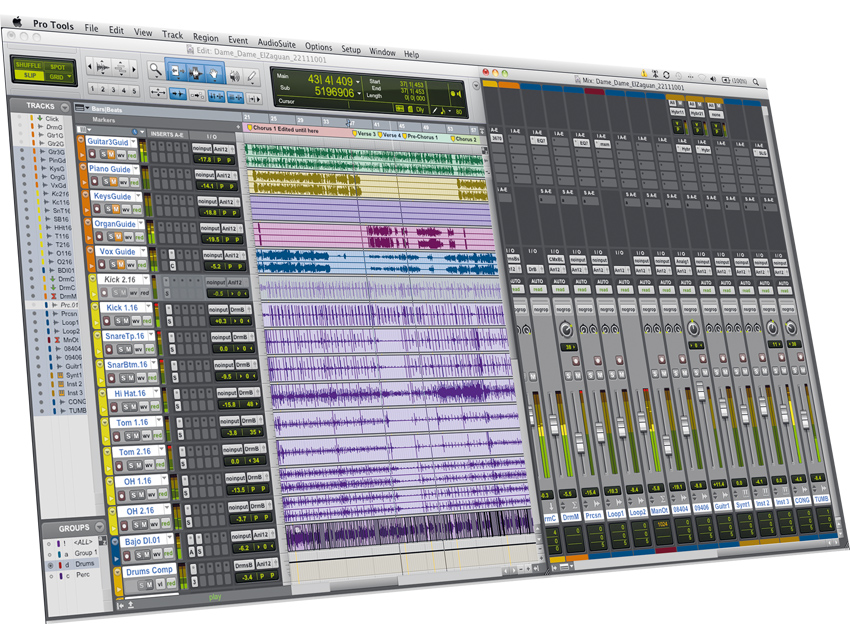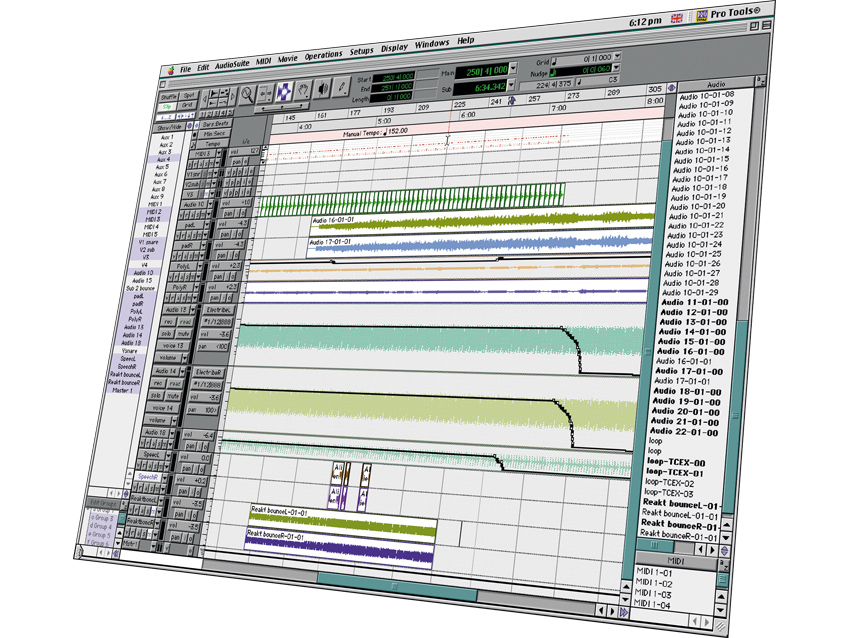A brief history of Pro Tools

Pro Tools

Pro Tools
Avid's Pro Tools, originally developed by Digidesign, looms over the DAW world like a colossus, widely considered to be the industry standard digital recording solution.
Most contemporary DAWs were created by companies with prior experience of music software and hardware development, and Pro Tools is no exception.
"The Pro Tools concept has always been based around the digital audio workstation, combining hardware and software."
The story starts in 1983 with the release of E-MU's Drumulator drum machine. A companion to the Emulator sampling keyboard and antecedent to the equally legendary SP-12 and SP-1200 samplers, the Drumulator was a relatively simple digital unit with EPROM- based memory for its non-editable 12-bit samples.
The Drumulator was a hit despite the fact users were limited to its built-in sounds. Enter Evan Brooks and Peter Gotcher, high school buddies and University of California graduates with a shared interest in music, recording, electronic engineering and computer programming.
After consulting E-MU for details of the Drumulator's memory system, the duo set about creating new sound libraries and formed a company, Digidrums, to offer a series of upgrade EPROM microchips just a year after the release of the drum machine itself.
Digidrums' hugely successful range of chips were simple enough for Drumulator owners to swap in and out as desired, offering everything from Simmons electronic drum sounds to John Bonham-inspired 'heavy metal' samples.
However, Brooks and Gotcher anticipated that users would soon crave more than just a selection of alternative preset sounds. Luckily, they were already working on a solution.
Get the MusicRadar Newsletter
Want all the hottest music and gear news, reviews, deals, features and more, direct to your inbox? Sign up here.
Having recorded the Digidrums samples on Sony's videotape-based PCM-F1 digital recording processor, the duo were keen to find a less cumbersome and more flexible option.
Identifying the audio potential of the newly released Macintosh computer, they set about creating basic digital audio recording and editing software for their own use. Despite their primary interest in making their own lives easier, it soon became apparent that the software should be developed for general release.
Working in conjunction with E-MU, Digidrums changed its name to Digidesign and began work developing a groundbreaking Mac-based sample editing system for the Emulator II keyboard.
Released in 1985 at a price of $995, Sound Designer brought the visual editing features of exotic instruments like the Synclavier and Fairlight to a much larger market.
Although at this stage sampling was beyond the reach of most consumers and amateur musicians, Digidesign developed new versions of the software for each new sampler that hit the market, eventually releasing a Universal application, which could be used with all the most popular hardware by the likes of Akai, Roland and E-MU.
Sound Tools
Having successfully mastered software sample editing, a fully featured digital audio recording and processing solution was, in retrospect, the logical next step.
Sound Tools, released in 1989, was Digidesign's first attempt at a computer-based hardware direct-to-disk recording solution with a software front end.
Essentially, Brooks and Gotcher wanted to design a digital recording solution based on what they'd learned from Sound Designer but decided the Mac's 8-bit AD/DA conversion capabilities weren't up to scratch.
Hooking up a separate 16-bit interface to the Mac, it then became apparent that any serious signal processing was going to push the computer's processor to its absolute limit. Even carrying out very basic edits meant having to wait for the computer to process the signal, making for an infuriating stop-start workflow.
"With the pros catered for, Digidesign began to target the budget-conscious consumer."
The solution came in 1987 with the release of the Macintosh II, complete with six NuBus expansion slots. Brooks built an expansion card equipped with a 16-bit DA converter and a prototype Motorola DSP chip, allowing Sound Designer to use the DSP chip rather than the computer's CPU for its audio editing.
After showing off the prototype at the NAMM trade show, Digidesign set about developing a full audio input, output and processing system, eventually producing the 16-bit Sound Accelerator card, DAT-I/O digital interface and AD In analogue interface.
Pro Tools
The Sound Tools system's stereo audio features were groundbreaking, but the move to multitrack recording with the release of the Pro Tools system was a logical progression for Digidesign.
Released in 1991, the first version of Pro Tools was based around a similar hardware-software hybrid setup to Sound Tools, this time with a four-channel interface. Priced at nearly $6,000, the software side of the system was handled by Digidesign's ProEDIT program and ProDeck, a newly designed version of OSC's Deck application.
However, the Digidesign team soon admitted that relying on a third party to develop part of the Pro Tools software was a mistake. Version 2, released early in 1993, brought the software back in-house and introduced the now-familiar Pro Tools application.
Pro Tools II also introduced TDM (Time Division Multiplexing), a system that allows complex routing of multiple digital audio signals between DSP cards and enables Pro Tools to run multiple real-time DSP-based TDM plug-ins simultaneously.
The early '90s was an incredibly exciting time for the development of music software. Steinberg and Emagic were hot on Digidesign's heels, readying audio-capable versions of Cubase and Logic for release. In order to maximise its potential market share, Digidesign wisely opted to license its Digital Audio Engine (DAE) to other software developers.
As such, users of other DAWs could take advantage of Pro Tools hardware and run DSP-based TDM plug-ins without using the Pro Tools software as the front end.
Hardware
The Pro Tools concept has always been based around the digital audio workstation, combining hardware and software to create a complete package throughout the 1990s. Digidesign (which merged with American audio-visual giants Avid - now also owner of M-Audio, Sibelius and Euphonix - in 1994) continually refined both the software front end and the DSP and I/O capabilities of the Pro Tools platform.
From its humble 16-bit stereo origins as Sound Tools, Pro Tools progressed to 24-bit resolution and 24 tracks of audio by 1997. By this stage, Pro Tools was used alongside tape machines in most professional studios and starting to replace it altogether in many more.
"For the first time in Pro Tools' history there are no specific hardware requirements."
With the professional market well catered for, Digidesign also began to target the more budget-conscious consumer market in 1999 with the introduction of the Digi001 package, comprising a rackmount 24-bit 44.1/48kHz 8-in/8-out audio interface with 1-in/1-out MIDI connections, a PCI card with no DSP capabilities and Pro Tools LE, a stripped down 24-track version of the software front end.
Mid-range consumers continue to form a key part of Avid's client base, and the range has been regularly updated over the years, with the addition of the 002 control surface/interface in 2001 and the arrival of the current 003 control surface and 003 Rack in 2007. Strong rumours suggest an updated 004 is just around the corner.
Industry standard
2002 saw Apple buy out Emagic, acquiring the rights to Logic, and Steinberg announce Cubase SX, rewritten from the ground up and based on the Nuendo audio engine.
Digidesign hit back with Pro Tools HD, an update focusing mainly on new hardware choices rather than dramatic overhauls of the software front end.
With the introduction of the 192 I/O interface and new HD Core and Process cards (soon followed by the even more powerful HD Accel cards) Pro Tools offered substantially more recording flexibility and DSP power than ever before.
Over the past decade, Pro Tools has come to define the workflow of most modern studios. Consistently staying at the front of the pack with regular software updates, Pro Tools offers audio editing options which exploit its DSP power to the maximum. Beat Detective (introduced in PT5, 2001), Elastic Audio (PT7.4, 2007) and Elastic Pitch (PT8, 2008) have become essential tools for recording and mix engineers.
Last year's overhaul of the Pro Tools product line, now rebranded as an Avid product, refined the range even further. The software is now available in three varieties: Pro Tools 9, 9 HD Native and 9 HD. The former is roughly equivalent to the previous LE or M-Powered editions, but for the first time in Pro Tools' history there are no specific hardware requirements.
HD Native is the full software package for non-DSP Digidesign hardware, while HD is the full TDM-equipped flagship product. On the hardware side, updates to the Mboxes and HD series interfaces brought the range right up to date.
In two decades, Pro Tools has done more than any other product to revolutionise the way we record, edit and mix music using computers. Critics may argue that its MIDI and sequencing capabilities lag behind most other DAWs or that its software and hardware features are no longer superior to cheaper alternatives.
However, the release of PT 9, hardware independence and continual enhancement of the feature set suggest that Pro Tools is sure to remain an industry standard for the foreseeable future.
Future Music is the number one magazine for today's producers. Packed with technique and technology we'll help you make great new music. All-access artist interviews, in-depth gear reviews, essential production tutorials and much more. Every marvellous monthly edition features reliable reviews of the latest and greatest hardware and software technology and techniques, unparalleled advice, in-depth interviews, sensational free samples and so much more to improve the experience and outcome of your music-making.










